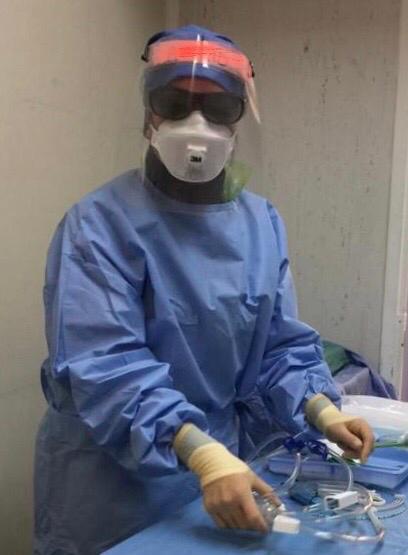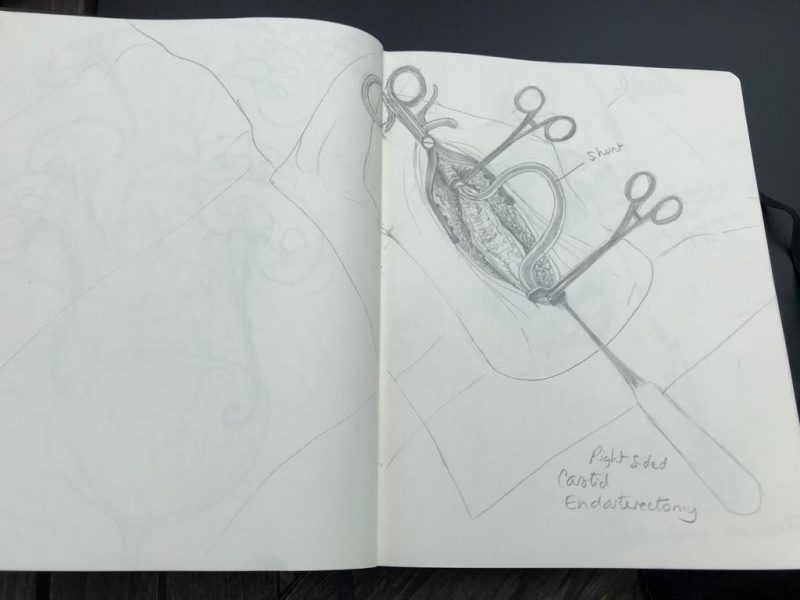Words Posy Gentles Photographs Astrid Ji Sun Sjogren and Yasmin Hossain

Spinal Block by Ji Sun Sjogren
Astrid Ji Sun Sjogren is a scrub nurse with a degree in Fine Art; she is working on a project she calls A Day in the Life of a Scrub Nurse.
Each day when Ji Sun gets home from the toils and urgency of the operating theatre, she draws a picture remembered from her day’s work in the hospital and uploads it on to her Instagram site, Scrubbartist. Among these works, she has made a detailed anatomical drawing of an amputation below the knee, and a cataractous eye; she has drawn the meticulous process of draping a patient for operation, and the scene of runners fetching essential supplies from the storeroom. Her drawings are touching (an old lady vaguely wanders off and is gently reorientated by a nurse) and can turn your stomach (the insertion of a laryngeal mask tube) and sometimes both (a man sits patiently, his anti-embolism stockings pulled up, while a spinal block procedure takes place).

Basic Morning Checklist by Ji Sun Sjogren

Pediatrics Handover: Sketch by Ji Sun Sjogren
Ji Sun became a scrub nurse a year and a half ago and her role ranges from preparing and checking all the necessary instruments and equipment needed for each operation, to making safety checks and coordinating and managing the operating theatre and the wellbeing of the patient. She is the person handing instruments to the surgeon as they work and making sure all runs smoothly. She is the one who checks the patient’s ID and consent form and makes sure it is the right patient for the right operation. Without the scrub nurse, we could lurch into nightmare! ‘Above all a scrub nurse has to be calm and have an eye for detail – thinking ahead and also laterally,’ says Ji Sun.

Ji Sun, scrub nurse
She started drawing as an aide-memoire. ‘I was confronted with a pile of emotional anxieties as a newly qualified nurse with the expectations of the surgical team. As a visually-minded sort of a person, I began to sharpen my observational skills, memorise, document, and learn everything through trial and error.
‘When lockdown happened, I had to slow down massively and it gave me a lot of time to reflect,’ she says. ‘Originally, the drawings were for my own benefit – an opportunity to practise my drawing skills to gain greater dexterity and an exercise in mental recall to check my accuracy. Then the project developed out of my need to express and explain what scrub nurses do as I do get asked that question and it’s difficult to describe it in a few words.’

Covid PPE for Surgery: Sketch by Ji Sun Sjogren
Ji Sun is in the unique position of being both an artist and a scrub nurse. She has an informed and unsqueamish eye and the talent to draw what she sees and understands – not just the clichéd glamour of the celebrity surgeon with his masked and anonymous minions on hand (‘Scalpel please, Nurse!’), but the whole team including the operating department practitioners, the theatre support workers, the porters, the recovery nurses and many others.

Scrub Trolleys by Ji Sun Sjogren
Ji Sun says: ‘Getting a true understanding of what each machine does, and what instruments are being used is truly impossible to achieve unless it’s a daily occurrence. Even among team members, some have distorted ideas of the reality of each other’s roles. Every role is just as complex and important in its right and one could easily write a book for each one. The curiosity hangs in the background details that help produce the piece of magic occurring inside these rooms. Contrary to common belief, blood and gore is only a small part of it.
‘The beauty about drawing is that I can do what I like. The biggest problem in real life coverage is timing. So many things happen at once so all I can do is recreate an impression of what goes on. Everything is recorded in my head. My advantage over other artists is that I know about what I’m looking at, and I tell a story. Each image has a narrative; none of it can be photographed as I can’t just stop everyone and shout “Photo time!”’
Ji Sun’s drawings are in the spirit of the finely observed and executed drawings of disease, disfigurement and dissection of previous centuries with their strangely compelling beauty, before photography snapped on to the scene. ‘I love disease in a way,’ she says. ‘I find it really fascinating.’ Her drawing of renal stones could be a design from The Festival of Britain, and the staghorn kidney stone looks like some delicate detail of a starfish.

Staghorn stone by Ji Sun Sjogren

Right-sided Carotid Endarterectomy by Ji Sun Sjogren
Ji Sun says her interest in anatomy dates to her primary education in a Montessori school in Brussels. ‘The basic skills I learned there taught me to look at things properly.’ At the age of nine or ten, the pupils, in groups of three, were given a dead rabbit to dissect. Ji Sun’s fellows didn’t have the stomach for it, and she alone was left, enthralled, to prise skin from muscle.
Text: Posy Gentles. Photographs: Astrid Ji Sun Sjogren and Yasmin Hossain
Find Ji Sun’s work on Instagram under Scrubbartist